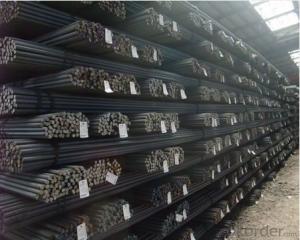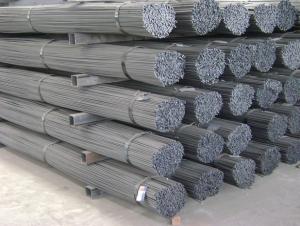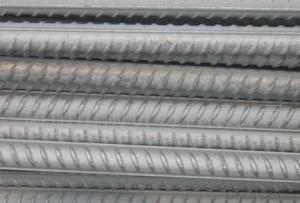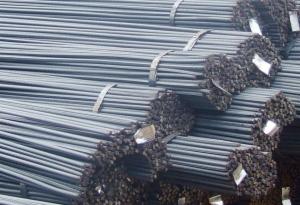Stainless Deformed Steel Rebars with High Quality
- Loading Port:
- Tianjin
- Payment Terms:
- TT OR LC
- Min Order Qty:
- 100 m.t.
- Supply Capability:
- 5000 m.t./month
OKorder Service Pledge
OKorder Financial Service
You Might Also Like
Product Description:
OKorder is offering Stainless Deformed Steel Rebars with High Quality at great prices with worldwide shipping. Our supplier is a world-class manufacturer of steel, with our products utilized the world over. OKorder annually supplies products to European, North American and Asian markets. We provide quotations within 24 hours of receiving an inquiry and guarantee competitive prices.
Product Applications:
Stainless Deformed Steel Rebars with High Quality are ideal for structural applications and are widely used in the construction of buildings and bridges, and the manufacturing, petrochemical, and transportation industries.
Product Advantages:
OKorder's Stainless Deformed Steel Rebars with High Quality are durable, strong, and resist corrosion.
Main Product Features:
· Premium quality
· Prompt delivery & seaworthy packing (30 days after receiving deposit)
· Corrosion resistance
· Can be recycled and reused
· Mill test certification
· Professional Service
· Competitive pricing
Specifications of Deformed Steel Rebars with High Quality:
Standard | GB UK USA | HRB335 HRB400 HRB500 G460B, B500A, B500B,B500C GR40, GR60 | |
Diameter | 6mm,8mm,10mm,12mm,14mm,16mm,18mm,20mm, 22mm,25mm,28mm,32mm,36mm,40mm,50mm | ||
Length | 6M, 9M,12M or as required | ||
Packing | Export standard packing: wrapped by wire rod in bundles | ||
Each bundle weight | 2-3MT, or as required | ||
Trade terms | FOB, CFR, CIF | ||
Payment terms | TT payment in advance or Irrevocable LC at sight. | ||
Delivery Detail | within 45 days after received advanced payment or LC. | ||
Brand name | DRAGON | ||
Theoretical weight and section area of each diameter as below for your information:
Diameter(mm) | Section area (mm²) | Mass(kg/m) | Weight of 12m (kg) | Pcs/ton |
6 | 28.27 | 0.222 | 2.664 | 375.38 |
8 | 50.27 | 0.395 | 4.74 | 210.97 |
10 | 78.54 | 0.617 | 7.404 | 135.06 |
12 | 113.1 | 0.888 | 10.656 | 93.84 |
14 | 153.9 | 1.21 | 14.52 | 68.87 |
16 | 201.1 | 1.58 | 18.96 | 52.74 |
18 | 254.5 | 2.00 | 24 | 41.67 |
20 | 314.2 | 2.47 | 29.64 | 33.74 |
22 | 380.1 | 2.98 | 35.76 | 27.96 |
25 | 490.9 | 3.85 | 46.2 | 21.65 |
28 | 615.8 | 4.83 | 57.96 | 17.25 |
32 | 804.2 | 6.31 | 75.72 | 13.21 |
36 | 1018 | 7.99 | 98.88 | 10.43 |
40 | 1257 | 9.87 | 118.44 | 8.44 |
50 | 1964 | 15.42 | 185.04 | 5.40 |
Chemical Composition: (Please kindly find our chemistry of our material based on JIS as below for your information)
JISG3112 SD390 | Chemical Composition | ||||
C | Mn | Si | S | P | |
0.22 | 1.38 | 0.4 | 0.014 | 0.022 | |
Physical capability | |||||
Yield Strength(N/cm²) | Tensile Strength(N/cm²) | Elongation (%) | |||
620 | ≥400 | 21 | |||
The production process of Steel Rebar
1-Waling beam furnace
2-Roughing rolling group
3-Intermediate rolling train
4-Finishing rolling group
5-Water-cooling device
6-Walking beam cooler
7-Finishing equipment(including the cold scale shear,short feet collection system,
automatic counting device,bundling machine, collect bench)
Usage and Applications of Deformed Steel Rebars with High Quality:
Deformed bar is widely used in buildings, bridges, roads and other engineering construction. Big to highways, railways, bridges, culverts, tunnels, public facilities such as flood control, dam, small to housing construction, beam, column, wall and the foundation of the plate, deformed bar is an integral structure material. With the development of world economy and the vigorous development of infrastructure construction, real estate, the demand for deformed bar will be larger and larger..
Packaging & Delivery of Deformed Steel Rebars with High Quality:
Packaging Detail: products are packed in bundle and then shipped by container or bulk vessel, deformed bar is usually naked strapping delivery, when storing, please pay attention to moisture proof. The performance of rust will produce adverse effect.
Price: Keep lower operating costs so as to offer competitive price for our clients
FAQ:
Q1: Why buy Materials & Equipment from OKorder.com?
A1: All products offered byOKorder.com are carefully selected from China's most reliable manufacturing enterprises. Through its ISO certifications, OKorder.com adheres to the highest standards and a commitment to supply chain safety and customer satisfaction.
Q2: How do we guarantee the quality of our products?
A2: We have established an advanced quality management system which conducts strict quality tests at every step, from raw materials to the final product. At the same time, we provide extensive follow-up service assurances as required.
Q3: How soon can we receive the product after purchase?
A3: Within three days of placing an order, we will begin production. The specific shipping date is dependent upon international and government factors, but is typically 7 to 10 workdays.


- Q: What are the guidelines for proper storage and transportation of steel rebars?
- The guidelines for proper storage and transportation of steel rebars are essential to ensure their integrity and quality. Here are some important guidelines to follow: 1. Storage: Steel rebars should be stored in a clean, dry, and well-ventilated area to prevent corrosion. They should be placed on a flat surface to avoid distortion or bending. Stacking should be limited to prevent excessive weight on the lower rebars, which can lead to deformation. 2. Protection: Steel rebars should be protected from exposure to moisture, rain, and direct sunlight. They should be covered with a waterproof tarp or plastic sheeting to prevent rusting. Rust can weaken the rebars and compromise their structural integrity. 3. Separation: Different sizes and grades of rebars should be stored separately to avoid confusion and ensure easy access. Additionally, rebars should be kept away from other materials that can cause damage or contamination. 4. Handling: When handling steel rebars, proper lifting techniques should be employed. Forklifts or cranes with appropriate lifting equipment should be used to prevent damage or injuries. The rebars should not be dragged or dropped, as this can cause deformation or cracking. 5. Transportation: During transportation, steel rebars should be secured properly to prevent shifting or movement that can lead to damage. Adequate cushioning materials, such as wooden blocks or rubber pads, should be used to minimize vibration and impact. Additionally, rebars should be covered to protect them from road debris and adverse weather conditions. 6. Documentation: Proper documentation is necessary for tracking the origin, size, and grade of the rebars. This information helps in ensuring compliance with industry standards and quality control measures. By adhering to these guidelines, the risk of damage, deformation, and corrosion to steel rebars during storage and transportation can be significantly reduced. This ensures that the rebars maintain their structural integrity and are fit for use in construction projects.
- Q: Can steel rebars be used in offshore oil and gas platforms?
- Yes, steel rebars can be used in offshore oil and gas platforms. Steel rebars are commonly used in construction projects to reinforce concrete structures, and offshore platforms are no exception. These platforms are subjected to various environmental and operational factors such as wave loads, wind forces, and seismic activities. The use of steel rebars helps to strengthen the structural integrity and enhance the overall stability of the platforms. However, it is crucial to use corrosion-resistant steel rebars in offshore applications due to the harsh marine environment. The presence of saltwater, humidity, and exposure to chemicals can accelerate the corrosion process. Therefore, stainless steel rebars or epoxy-coated rebars are often preferred for offshore platforms to ensure long-term durability and prevent corrosion-related issues. Furthermore, it is essential to comply with relevant industry standards and regulations when using steel rebars in offshore oil and gas platforms. These standards outline specific requirements for material selection, fabrication, installation, and inspection to ensure the safety and reliability of the structures. In summary, steel rebars can be effectively used in offshore oil and gas platforms to reinforce concrete structures and enhance their strength and stability. However, the selection of corrosion-resistant steel rebars and adherence to industry standards are critical considerations to withstand the challenging marine environment and ensure the long-term integrity of the platforms.
- Q: What are the advantages of using fiber-reinforced polymer (FRP) rebars over steel rebars?
- There are several advantages of using fiber-reinforced polymer (FRP) rebars over traditional steel rebars in construction projects: 1. Corrosion resistance: One of the main advantages of FRP rebars is their excellent resistance to corrosion. Unlike steel rebars, which are prone to rust and deterioration when exposed to moisture and chemicals, FRP rebars do not corrode. This property significantly increases the durability and lifespan of structures, particularly in harsh environmental conditions. 2. Lightweight: FRP rebars are significantly lighter than steel rebars, making them easier to handle, transport, and install. This lightweight characteristic also reduces the overall dead load of a structure, allowing for more efficient design and construction. 3. High strength-to-weight ratio: Despite being lightweight, FRP rebars have a high strength-to-weight ratio, meaning they can carry heavy loads while still maintaining their structural integrity. This property makes FRP rebars ideal for applications where weight reduction is desired without compromising on strength, such as in bridge decks and seismic reinforcement. 4. Non-magnetic and non-conductive: Unlike steel rebars, FRP rebars are non-magnetic and non-conductive. This feature is particularly advantageous in structures that require non-magnetic properties, such as MRI rooms in hospitals, or in situations where electrical conductivity needs to be minimized, such as in power plants or near electrical equipment. 5. Design flexibility: FRP rebars can be manufactured in various shapes and sizes, offering design flexibility and customization options to meet specific project requirements. They can be easily cut and shaped on-site, allowing for easy integration into complex geometries and curved structures. 6. Thermal compatibility: FRP rebars have a low coefficient of thermal expansion, which means they expand and contract at a similar rate to the surrounding concrete. This thermal compatibility minimizes the risk of cracking and ensures better long-term performance of the structure, particularly in areas with extreme temperature variations. 7. Excellent durability: FRP rebars exhibit excellent long-term durability, even in aggressive environments. They are resistant to alkalis, chemicals, and UV radiation, ensuring their performance and structural integrity over an extended period. 8. Environmental friendliness: FRP rebars are considered more environmentally friendly than steel rebars due to their minimal carbon footprint. They require less energy to produce and generate fewer greenhouse gas emissions during manufacturing. Additionally, FRP rebars are non-toxic and do not pose a threat to the environment during their lifespan or at the end of their service life. Overall, the advantages of using FRP rebars over steel rebars make them a viable alternative in various construction applications, offering improved durability, lightweight design, corrosion resistance, and enhanced structural performance.
- Q: Can steel rebars be used in railway track construction?
- Yes, steel rebars can be used in railway track construction. They are commonly used as reinforcement in concrete sleepers or ties, which form the base for railway tracks. The rebars provide strength and durability to the sleepers, ensuring the stability and longevity of the railway tracks.
- Q: Can steel rebars be used in precast concrete?
- Indeed, precast concrete can make use of steel rebars. It entails fabricating concrete components away from the construction site and subsequently transferring them for installation. Generally, steel rebars are incorporated into precast concrete elements to furnish reinforcement and bolster the strength and resilience of the concrete structure. During the manufacturing process, these rebars are typically embedded inside the precast concrete elements, guaranteeing a cohesive interaction between the concrete and steel to counteract tensile forces and forestall cracks or structural failure. This amalgamation of steel rebars and precast concrete yields robust, dependable, and efficient construction elements that can be easily erected on-site.
- Q: What are the guidelines for proper splicing of steel rebars in concrete structures?
- The guidelines for proper splicing of steel rebars in concrete structures include ensuring proper alignment and overlap between rebars, using appropriate splicing methods such as lap splices or mechanical couplers, and ensuring adequate concrete cover over the spliced area. Additionally, it is essential to follow the specific codes and regulations set by relevant authorities and consult structural engineers for accurate and safe splicing practices.
- Q: What are the properties of steel rebars?
- Steel rebars, also known as reinforcing bars, are essential components in reinforced concrete structures. They possess several properties that make them suitable for this purpose. Firstly, steel rebars have high tensile strength. This means they can withstand significant pulling forces without breaking. This property is crucial in reinforcing concrete structures, as concrete itself has low tensile strength. The combination of steel rebars and concrete creates a composite material that can withstand both tension and compression forces effectively. Secondly, steel rebars have excellent ductility. Ductility refers to the ability of a material to deform under stress without fracturing. This property is important in seismic regions where structures need to withstand earthquakes. The ductility of steel rebars allows them to absorb and redistribute energy during an earthquake, enhancing the overall resilience of the reinforced concrete structure. Additionally, steel rebars have good bond strength with concrete. The surface of rebars is often ribbed or deformed, providing increased contact area between the steel and concrete. This enhances the adhesion between the two materials, preventing slippage or separation under load. The bond strength ensures that the steel rebars and concrete act together as a single unit, improving the overall structural integrity. Moreover, steel rebars possess corrosion resistance. They are typically made of carbon steel, which is prone to rusting when exposed to moisture and oxygen. To mitigate this issue, rebars are often coated with epoxy or galvanized to provide a protective layer against corrosion. This corrosion resistance ensures the longevity and durability of the reinforced concrete structure. Lastly, steel rebars are readily available and cost-effective. Steel is one of the most widely used construction materials globally, making rebars easily accessible in various sizes and grades. The abundance of steel and efficient production processes make rebars a cost-effective solution for reinforcing concrete structures. In conclusion, steel rebars possess high tensile strength, excellent ductility, good bond strength with concrete, corrosion resistance, and are readily available at a reasonable cost. These properties make them an ideal choice for reinforcing concrete structures, ensuring their strength, durability, and resilience.
- Q: How do steel rebars affect the overall ductility of concrete structures?
- Steel rebars greatly enhance the overall ductility of concrete structures. By providing tensile strength, rebars prevent concrete from cracking and failing under tensile loads. This reinforcement allows the concrete to deform and absorb energy before reaching its ultimate failure point, ensuring the structure's ability to withstand seismic forces and other extreme loads.
- Q: Can steel rebars be used in underground structures?
- Yes, steel rebars can be used in underground structures. They provide strength and reinforcement to the concrete, making it capable of withstanding the pressure and load of the underground environment. Additionally, steel rebars have excellent resistance to corrosion, which is crucial in underground structures where moisture and other environmental factors may accelerate deterioration.
- Q: Do steel rebars increase the overall weight of a structure?
- Yes, steel rebars do increase the overall weight of a structure. Rebars are typically used to reinforce concrete, providing additional strength and stability. Since steel is denser than concrete, the addition of rebars adds weight to the structure.
Send your message to us
Stainless Deformed Steel Rebars with High Quality
- Loading Port:
- Tianjin
- Payment Terms:
- TT OR LC
- Min Order Qty:
- 100 m.t.
- Supply Capability:
- 5000 m.t./month
OKorder Service Pledge
OKorder Financial Service
Similar products
Hot products
Hot Searches
Related keywords
































